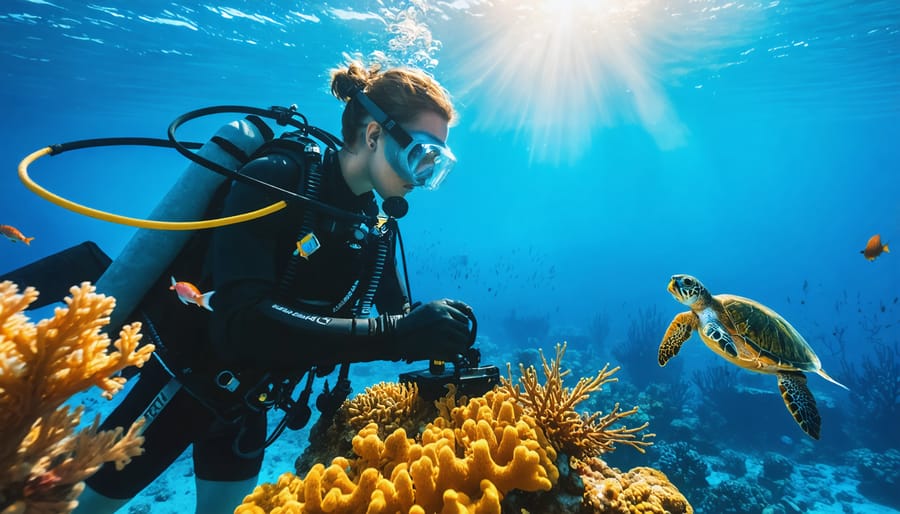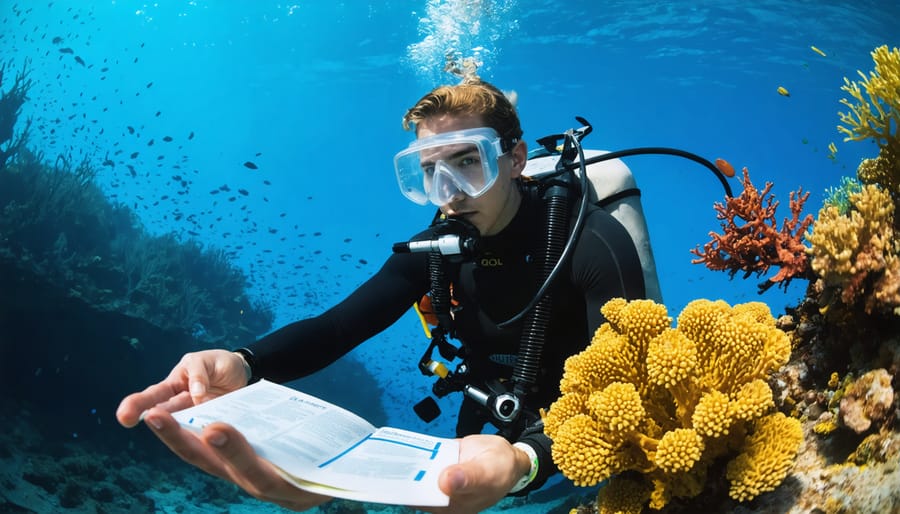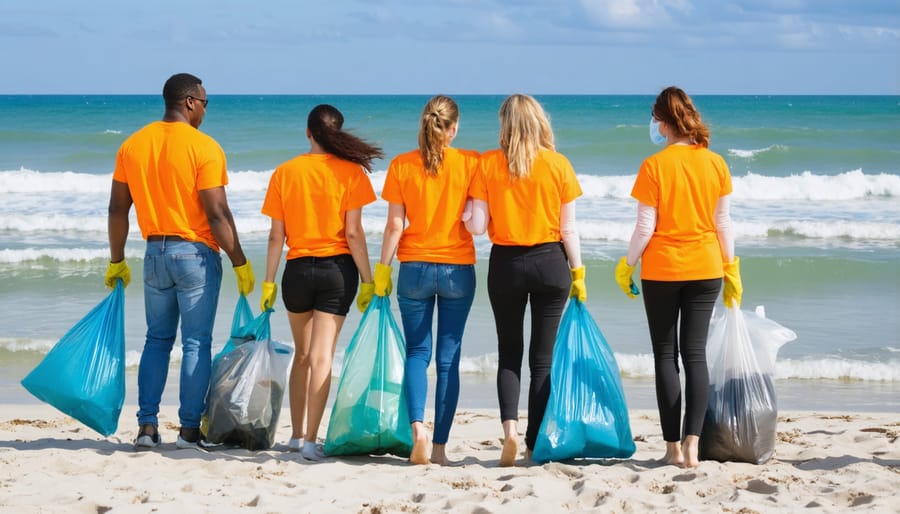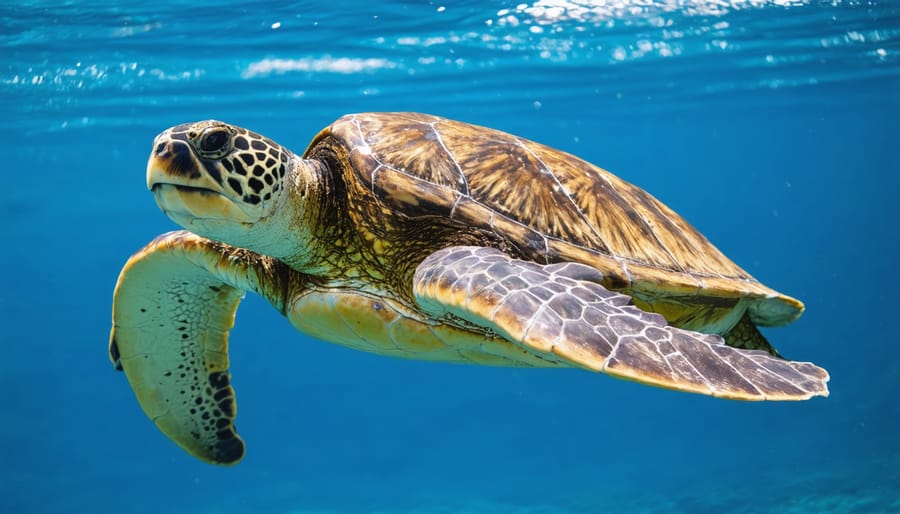
Beneath the ocean’s surface, a dedicated group of professionals stands as guardians of our marine ecosystems. Marine life conservationists combine scientific expertise with unwavering dedication to protect and preserve the delicate balance of aquatic life. From studying endangered species in remote coral reefs to implementing crucial protection measures in coastal waters, these environmental stewards work tirelessly to ensure the survival of marine biodiversity for future generations.
Their work extends far beyond traditional research, encompassing everything from habitat restoration and species monitoring to public education and policy advocacy. In an era of unprecedented environmental challenges – including ocean acidification, plastic pollution, and climate change – marine life conservationists serve as both scientists and advocates, using their expertise to bridge the gap between complex marine ecology and actionable conservation solutions.
The impact of their work ripples through entire ecosystems, from microscopic plankton to magnificent whale populations. By understanding the intricate connections between marine species and their environments, these professionals develop innovative strategies to protect vulnerable species while promoting sustainable practices that benefit both marine life and human communities dependent on ocean resources.
As our oceans face mounting pressures, the role of marine life conservationists becomes increasingly vital in safeguarding the future of our blue planet.
The Modern Marine Life Conservationist
Essential Skills and Qualifications
A bachelor’s degree in marine biology, environmental science, or a related field is typically required, with many professionals pursuing advanced degrees for research positions. Essential certifications include SCUBA diving certification (PADI or equivalent), underwater research techniques, and marine wildlife handling permits.
Key technical skills include species identification, data collection and analysis, GPS navigation, and proficiency with research equipment. Strong swimming abilities and physical fitness are crucial for fieldwork. Expertise in using statistical software, GIS mapping tools, and underwater photography equipment is highly valuable.
Soft skills are equally important. These include project management capabilities, excellent communication skills for public education and stakeholder engagement, and the ability to work in diverse teams. Problem-solving abilities and adaptability are essential, as field conditions can be unpredictable.
Experience in grant writing and fundraising is beneficial, as many conservation projects rely on external funding. Knowledge of environmental regulations, marine protection laws, and policy frameworks is crucial. Proficiency in scientific writing and research methodology is necessary for documentation and publishing findings.
First aid certification, boat handling skills, and experience with marine rescue techniques are additional valuable qualifications that enhance effectiveness in the field.
Daily Life on the Job
A typical day for a marine life conservationist varies greatly depending on location and specific projects, but it often begins before sunrise with field observations. Many spend their mornings conducting underwater surveys, monitoring coral reef health, or tracking critical marine species protection efforts. Data collection is a crucial daily task, involving photographing marine life, measuring water quality parameters, and documenting species behavior.
Afternoons might include laboratory work, analyzing collected samples, or updating research databases. Many conservationists collaborate with local communities and fishing industries to develop sustainable practices. They also spend time writing research papers, grant proposals, and public education materials.
Some days involve rescue operations for stranded marine mammals or sea turtles, requiring quick response and careful handling. Education and outreach are regular components, with conservationists leading workshops, giving presentations at schools, or training volunteers in conservation techniques.
Evening hours often involve analyzing the day’s findings, planning future expeditions, and coordinating with international conservation partners. The work requires adaptability, physical stamina, and unwavering dedication to marine ecosystem preservation.

Interactive Conservation Programs
Citizen Science Initiatives
Citizen science has become a cornerstone of marine conservation efforts, enabling researchers to collect vast amounts of data while engaging the public in hands-on scientific work. Through organized programs, volunteers participate in activities such as beach cleanups with data collection, coral reef monitoring, and marine mammal observation projects.
Popular initiatives include Reef Check, where recreational divers conduct standardized surveys of coral reef health, and the Whale and Dolphin Conservation’s Shore Watch program, which trains citizens to document cetacean sightings. These programs not only generate valuable scientific data but also create environmental stewards within local communities.
Digital platforms have revolutionized citizen science participation. Mobile apps like iNaturalist and Marine Debris Tracker allow anyone with a smartphone to contribute to global databases. These tools help scientists track species distribution, monitor pollution patterns, and identify emerging environmental threats in real-time.
Educational institutions and aquariums frequently partner with conservationists to run citizen science programs. For example, the National Ocean and Atmospheric Administration (NOAA) coordinates with schools for their Marine Debris Monitoring program, where students collect and categorize beach litter while learning about ocean conservation.
The success of these initiatives demonstrates how public participation can significantly expand the scope of marine research while fostering environmental awareness and community engagement. Many volunteers report that their participation leads to long-term commitment to marine conservation and environmental stewardship.

Educational Outreach
Educational outreach forms a crucial pillar of marine life conservation, connecting scientific research with public awareness and action. Marine conservationists develop and implement comprehensive marine education programs that reach diverse audiences, from elementary school students to local community groups and policymakers.
These initiatives often include interactive workshops, field trips to coastal areas, and hands-on experiences with marine ecosystems. Conservationists create age-appropriate curricula that explain complex marine biology concepts through engaging activities, such as touch tanks, beach clean-ups, and citizen science projects. Virtual reality technologies and digital platforms are increasingly being utilized to bring ocean experiences to inland communities and expand the reach of conservation messages.
School partnerships have proven particularly effective, with many conservationists working directly with teachers to integrate marine science into standard curricula. These collaborations often result in long-term projects where students monitor local waterways, participate in species counts, or create awareness campaigns about marine pollution.
Community-based programs focus on practical conservation skills and local marine issues. These might include workshops on sustainable fishing practices, training in marine wildlife rescue, or seminars on reducing plastic consumption. Success stories from these educational initiatives demonstrate how increased awareness leads to meaningful behavioral changes and community-driven conservation efforts.
Success Stories from the Field
Species Recovery Projects
Species recovery projects represent some of the most inspiring success stories in marine conservation. Through collaborative efforts between marine wildlife rehabilitators, scientists, and local communities, several endangered species have shown remarkable recovery. The Hawaiian monk seal population, for instance, has increased by 2% annually since 2013, thanks to intensive protection and habitat restoration efforts.
The California sea otter’s recovery stands as another testament to successful conservation. Their numbers have grown from just 50 individuals in 1938 to over 3,000 today through protected area management and rehabilitation programs. Similarly, the eastern Pacific gray whale has rebounded from near extinction to approximately 27,000 individuals, leading to its removal from the endangered species list.
These achievements demonstrate the profound impact of dedicated conservation efforts. By combining scientific research, habitat protection, and community engagement, conservationists continue to make significant strides in protecting marine species. The success of these projects provides hope and valuable lessons for future conservation initiatives, proving that with proper resources and commitment, endangered species can recover and thrive.

Community Impact
Marine life conservationists play a vital role in strengthening local communities through their dedication to ocean protection and sustainable resource management. Through community-based conservation efforts, these professionals help create sustainable fishing practices that protect both marine ecosystems and local livelihoods.
Their work often leads to the development of eco-tourism opportunities, providing alternative income sources for coastal communities while promoting environmental awareness. By establishing marine protected areas and implementing sustainable fishing guidelines, conservationists help ensure long-term food security and economic stability for local fishing communities.
Educational programs led by marine conservationists inspire the next generation of environmental stewards while creating jobs in conservation, research, and tourism sectors. These initiatives often result in improved coastal infrastructure, increased local expertise in marine science, and stronger community bonds through shared conservation goals.
The ripple effect of their work extends beyond environmental protection, fostering cultural preservation, particularly in communities with strong traditional ties to the ocean. This holistic approach to conservation creates resilient communities that are better equipped to face environmental challenges while maintaining their cultural heritage.
Getting Involved
Volunteer Opportunities
Numerous organizations worldwide offer volunteer opportunities for aspiring marine life conservationists. The Ocean Conservancy runs annual coastal cleanup programs and citizen science initiatives, while organizations like Project AWARE connect divers with marine conservation projects. Sea Turtle Conservancy welcomes volunteers for nesting beach monitoring and hatchling protection programs. Many aquariums and marine research centers offer volunteer positions, providing hands-on experience with marine life and public education.
To get involved, start by researching local marine conservation organizations and reaching out to their volunteer coordinators. Most programs require basic training, and some may need specific certifications, such as SCUBA certification for underwater work. Many opportunities are seasonal, particularly those involving wildlife monitoring or beach cleanup activities. Conservation centers often seek long-term volunteers for ongoing projects and educational programs, making them excellent starting points for gaining experience in the field.
Career Pathways
Becoming a marine life conservationist typically begins with earning a bachelor’s degree in marine biology, environmental science, or a related field. Many professionals also pursue master’s or doctoral degrees to specialize in specific areas like marine mammal behavior or coral reef ecology. Gaining practical experience through internships at aquariums, research centers, or conservation organizations is crucial during academic years.
Field experience is essential, often starting with volunteer work in coastal cleanup projects or citizen science programs. Many successful conservationists begin by participating in research expeditions or working as research assistants. Developing skills in scientific diving, data collection, and species identification strengthens career prospects.
Networking within the marine conservation community and joining professional organizations can lead to job opportunities. Career paths may include roles in research institutions, government agencies, non-profit organizations, or education centers, each offering unique ways to contribute to marine life protection.
Interactive marine conservation represents a vital bridge between scientific research and public engagement in protecting our ocean’s biodiversity. By participating in citizen science projects, supporting local conservation initiatives, or pursuing a career in marine conservation, each of us can contribute to the preservation of marine ecosystems for future generations. The time to act is now – our oceans face unprecedented challenges from climate change, pollution, and overfishing. Whether you’re a student, professional, or concerned citizen, there are countless ways to get involved and make a difference. Join the growing community of marine life conservationists, share your knowledge with others, and become part of the solution. Together, we can ensure the survival and prosperity of marine species and their habitats while inspiring the next generation of ocean stewards.
jessica
Ava Singh is an environmental writer and marine sustainability advocate with a deep commitment to protecting the world's oceans and coastal communities. With a background in environmental policy and a passion for storytelling, Ava brings complex topics to life through clear, engaging content that educates and empowers readers. At the Marine Biodiversity & Sustainability Learning Center, Ava focuses on sharing impactful stories about community engagement, policy innovations, and conservation strategies. Her writing bridges the gap between science and the public, encouraging people to take part in preserving marine biodiversity. When she’s not writing, Ava collaborates with local initiatives to promote eco-conscious living and sustainable development, ensuring her work makes a difference both on the page and in the real world.
